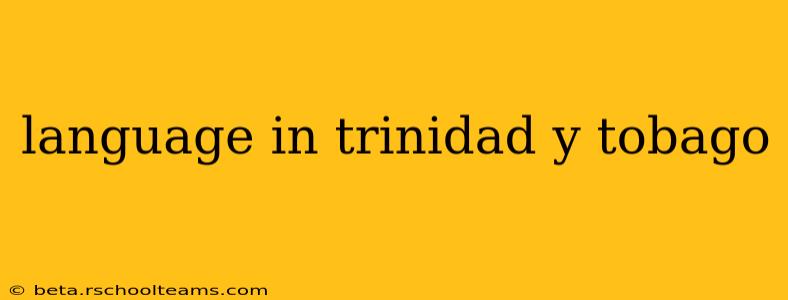Trinidad and Tobago, a vibrant island nation in the Caribbean, boasts a rich and diverse linguistic tapestry. While English is the official language, the reality on the ground is far more nuanced, reflecting the island's complex history and multicultural population. This post delves into the fascinating world of languages spoken in Trinidad and Tobago, exploring their origins, usage, and cultural significance.
English: The Official Tongue
English holds the official status, serving as the language of government, education, and commerce. However, the Trinbagonian version of English is far from standard British or American English. It's characterized by a unique accent, vocabulary, and grammatical structures, often influenced by the other languages spoken on the islands. This "Trinidadian English" is a significant part of the national identity and is readily understood throughout the country.
Trinidadian Creole: A Language of the People
Trinidadian Creole, also known as Trinidadian Patois, is arguably the most widely spoken language in everyday life. It's a vibrant, dynamic language with roots in various linguistic influences, primarily West African languages, English, French, Spanish, and indigenous languages. While it doesn't have an official status, it permeates everyday conversations, music, and popular culture. Understanding Creole is key to truly understanding Trinbagonian society and culture.
The Variations Within Creole:
It's important to note that Trinidadian Creole isn't monolithic. Variations exist across different regions and social groups, reflecting the heterogeneous nature of the population. These variations can range from subtle differences in pronunciation and vocabulary to more significant grammatical structures.
The Influence of Other Languages:
Trinidad and Tobago's linguistic diversity extends beyond English and Creole. The legacy of colonialism and immigration has left its mark, with smaller communities speaking:
- Hindi: Brought by indentured laborers from India, Hindi remains a significant language, particularly within specific communities.
- Spanish: Influenced by proximity to Venezuela and historical interactions, Spanish is spoken by a smaller but notable population.
- Chinese: The Chinese community contributes its own linguistic flavor to the Trinbagonian language landscape.
- Indigenous Languages (Carib): While largely lost, remnants of the original indigenous languages can still be found in place names and some cultural practices.
The Interplay of Languages: Code-Switching and Language Attitudes
Code-switching – seamlessly transitioning between languages within a single conversation – is incredibly common in Trinidad and Tobago. This reflects the fluid nature of language use and the deep integration of different linguistic traditions within society. Attitudes towards language are complex. While English holds official sway, Creole is often viewed with affection and pride, as a powerful symbol of local identity and cultural expression.
The Future of Language in Trinidad and Tobago
The linguistic landscape of Trinidad and Tobago is constantly evolving. While English maintains its official prominence, Creole remains the dominant language in everyday interactions. The influence of other languages continues, enriching the linguistic tapestry and shaping the nation's cultural identity. Understanding this rich linguistic diversity is vital for anyone seeking to engage with and appreciate the unique culture of Trinidad and Tobago.
Note: This post is for informational purposes only and does not represent a comprehensive linguistic analysis. Further research from linguistic experts is encouraged for deeper insights.
